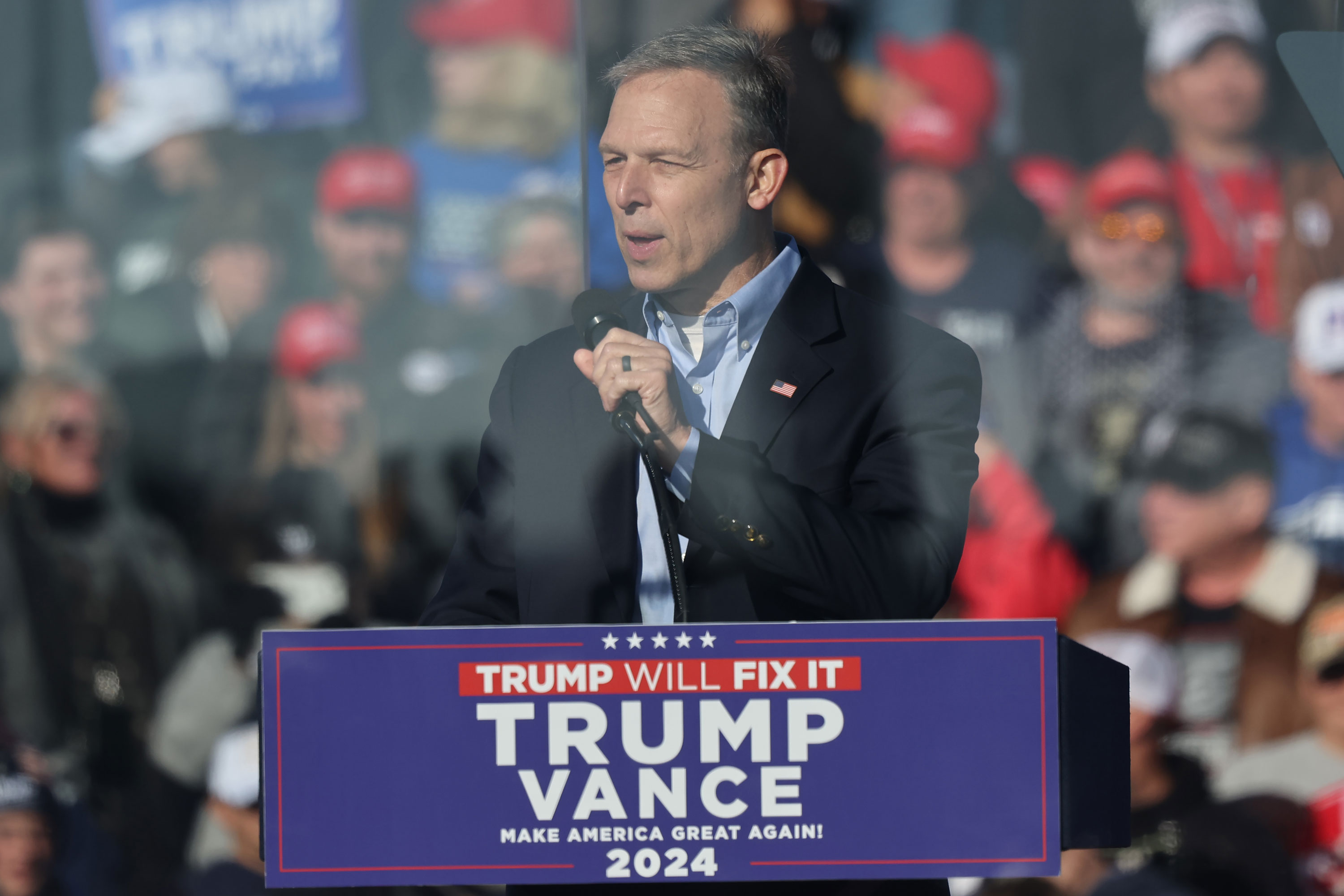Decision 2024
'What's next?' Politicians, pundits and parties are still trying to figure it out
To better understand what the election portends for Republicans, Democrats and Pennsylvania requires unpacking how key demographics voted – and why.

Then-presidential candidate Donald Trump holds a town hall at the Greater Philadelphia Expo Center on October 14, 2024 in Oaks, Pennsylvania. Spencer Platt/Getty Images
With just weeks to go until a second Donald Trump presidency – and the trifecta of a Republican-controlled Congress and conservative Supreme Court – becomes reality, the question of what comes next for each political party, both short- and long-term, in the wake of the 2024 election continues to loom large for politicians, pundits and party officials.
In the weeks since the election, conversations and reassessment strategies have focused on the state’s working-class and suburban voters, two of the voting blocs that helped Republicans ride a red wave through the commonwealth and the country. But how the GOP works for these demographics and others key to their victory – and how the Democrats work to recoup their losses among these same voters – will determine much of the next few years.
Republicans in array
Trump took back the commonwealth in 2024 by improving his margins across the state and in bellwether districts like Bucks, Erie and Northampton counties – areas that almost always correctly predict the winner of the presidential race.
But nothing illustrates Trump’s improvement across multiple key demographics like his performance in Northeast Pennsylvania, where he won over a coalition of voters in post-industrial cities and towns in the Poconos – similar to how President Joe Biden carried his hometown region and won statewide four years ago.
Overall, Trump’s vote total in the region rose by 6% compared to 2020, while Democratic presidential candidate and Vice President Kamala Harris’ vote total came in 4% lower than Biden’s – a 10% swing. In the state’s other 57 counties, the former president received 4% more votes than he did in 2020, and Harris received 3% less than Biden – a decisive 7% swing.
Republicans down the ticket benefited from change-minded voters as well, with state Rep. Ryan Mackenzie unseating three-term incumbent U.S. Rep. Susan Wild in the Lehigh Valley and first-time candidate Rob Bresnahan upsetting six-term incumbent U.S. Rep. Matt Cartwright in the district around Scranton. Despite the turnover, six-term U.S. Rep. Scott Perry – who served as chair of the Freedom Caucus – fended off Democratic challenger Janelle Stelson.

Throw in longtime Democratic U.S. Sen. Bob Casey conceded last week to GOP challenger Dave McCormick – and Republicans winning the three statewide row office races – and the red wave in Pennsylvania resulted in a near sweep of the major contests in the commonwealth, with Democrats barely retaining control of the state House of Representatives.
“You look at the working-class part of the Democratic Party that was there forever in (places like) Northampton County – deep Democratic, union and industrial roots,” Christopher Borick, director of Muhlenberg College’s Institute for Public Opinion, told City & State. “That’s gone. Unions are certainly still supportive of Democrats, but rank-and-file members have become much more Republican-leaning than they have been in the past.”
Based on the election results not only in Pennsylvania but across the country, the Republican Party continues to win over working-class voters, while the Democratic Party has captured the demographic of voters with college degrees.
As historically has been the case, voters blamed the party in control of the White House, Borick said, adding that what’s being seen by many as a resounding victory for Republicans also came during a cycle when “they had the wind at their back.”
“It’s unquestionably a really great victory for Republicans that should be noted and understood as exactly that – a really great cycle,” Borick said. “The reality is that the sea of red on the map is ultimately a shallow sea.”
What happened
What was seen as a coin-flip election not only for president, but also for many key congressional races, turned out to be largely a GOP victory across the board. While some Democrats held onto their seats, Trump flipped the state red, and multiple Republican challengers rode his coattails to upset wins in critical House and Senate races.
“What happens often when you see lots of wins on the margins, you take away a message that might not match the messages voters were sending,” Borick said. “For Republicans, I think that’s something that could be a concern in the next few years as they try to translate those electoral successes into policy. People voted clearly that they want changes in areas like the border and in economic performance. If things go well economically, Republicans will be rewarded.”
One of the Democratic congressional incumbents to hold onto their seat in the commonwealth, Western Pennsylvania U.S. Rep. Chris Deluzio, was able to fend off Republican challenger Rob Mercuri, taking home 53.9% of the vote and outpacing many other Democrats in the greater Pittsburgh region.
Deluzio said that while his campaign focused on economic and safety issues that can appeal to working-class voters, Democrats must be willing to “fight” in modern politics.
“The race I ran in my district, and even going back to my first run two years ago, I always had a very clear and strong economic message about fighting against monopolies and corporate power, bringing down costs and giving small businesses a shot,” Deluzio told City & State. “I’ve seen too many in my party, frankly, embrace a win-win ideology or a win-win framing. And, you know what, sometimes there’s a bad guy and you got to fight and beat them. I think we could use a little more fight in our party.”
At the same time, Borick said, the Democratic Party must recognize its mistakes while not overreacting to the outcome of one election cycle.
“The policies in Washington like the border and inflation – (Democrats) were kind of slow in their ability to get in front of them and it ultimately came back to bite them,” he said. “Working-class voters have a feeling of being ignored or looked down upon by the party or by government. How do you get around that? You have to find people and policies that bridge those divides.”

There is no shortage of post-game analyses positing that Democrats spent too much time and energy pushing back on Trump and his record when they should have been focusing on the dinner-table issues voters face daily.
In an interview with the TV newsmagaine “60 Minutes,” Wild said she thought the Jan. 6 insurrection and Trump’s criminal record “would change some people’s minds” but that it wasn’t “going to be the pivotal thing that would cost him this election.”
“Back in 2021, I would’ve said there is no way he could ever run for president. But over the last three years, I kind of assessed that it just wasn’t going to be a disqualifier,” Wild said. “I do think there was a lack of enthusiasm about the top of the ticket. I think a lot of us didn’t gauge (correctly) – just thinking that people were going to turn out to vote against Donald Trump was a miscalculation.”
What to expect
What’s next for both parties, with one seeking to maximize its power and the other picking up the pieces?
While the GOP has control of Congress and the White House, the Republican agenda could focus on anything and everything from taxes on tips and overtime wages to health care issues such as repealing the Affordable Care Act or restricting access to abortion care and contraception. Whichever path the party takes, it’s clear that there will be significant ramifications for Pennsylvania.
Even still, Borick told the Pittsburgh Tribune-Review, the results of potential abortion restrictions “may not have major, direct impacts on reproductive policy” in the commonwealth. A Trump administration could seek to push the Food and Drug Administration to place more restrictions on abortion medications and make it harder to access contraception, but with a Democrat-majority state Supreme Court and a strong pro-choice governor in Democrat Josh Shapiro, it’s unlikely the state would see any immediate restrictions on reproductive rights.

On energy and the economy, local Republicans are hopeful Trump’s policies will create a job boom and help working-class voters. Westmoreland County Republican Committee Chair Bill Bretz, who told the Tribune-Review he is optimistic about the economy under Trump, said eliminating taxes on overtime pay and tips could increase productivity.
“I think the immediate ramification for no tax on tips and no tax on overtime is you’re going to see people who are working in hospitality or in the gig economy are going to boost their bottom line,” Bretz said. “If people have more take-home pay, it’s going to improve their lifestyle, and it’s going to put more money back into the economy.”
For the Democratic Party, the countdown to reassess their messaging and reconnect with working-class voters has already begun.
“I certainly believe that the Democratic Party has to be the party for working people. It has to be the party that says, ‘If you work hard, you play by the rules, the American Dream ought to be yours,’” Deluzio told City & State. “We can never lose sight of that.”
The party needs look no further than Northampton County, a bellwether district that voted for Obama twice, before going to Trump in 2016, to Biden in 2020, then back to Trump in 2024.
For Democrats to begin rebuilding, experts like Borick say, they need to keep asking – and answering – the questions to help them understand how they got here and how they rebuild.
“The challenge for the Democratic Party,” Borick explained to City & State, “how you saw it in Northampton County and others, is: How do you keep the new members of your party – the higher-educated and highly engaged voters – that you’ve attracted during the last decade to the Democratic Party, while finding ways to make inroads back among the working class that transcends race and ethnicity?”
